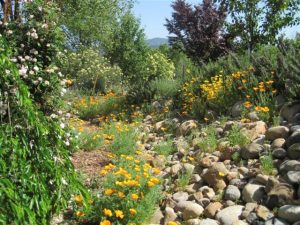The rugged beauty of a rock garden adds interest to an otherwise flat, humdrum landscape. The craggy cascade of rocks with colorful flowers and green, mounding plants make a naturalistic setting that is drought tolerant and, with the use of native plants, very environmentally friendly.
We are in our fourth year of a severe drought in California. Even if this winter turns out to be a wet one, the drought will still be with us. Although this is a challenge for gardeners, it isn’t impossible to have a beautiful garden, despite the rationing of water.
The best way to deal with limited water resources is to reduce the footprint of our gardens. This doesn’t mean we have to shrink our landscapes in any way. The addition of hardscape, like patios, walkways, stone walls, ponds and waterfalls, will greatly reduce the areas to be planted. The aesthetic appeal of a rock garden also enhances the interplay of flowers, trees and shrubs with stone.
Rock gardens needn’t be expensive, especially in our rocky soil, where the gardener’s handiest implement is a pick axe because of all the rocks buried under the hard ground. If your property doesn’t have rocks, then you will need to purchase them. This will be the most expensive part of this project, especially if you want boulders as part of the garden.
You need to decide whether to build the rock garden in the sun or in the shade, as this will determine what kinds of plants will thrive. In general, plants best suited to a rock garden are diminutive or moderate in size. Tall plants will obscure the rock behind them. According to Carol Bornstein, David Fross and Bart O’Brien in their book, “Reimagining the California Lawn,” “The rock structure of the garden is a permanent feature, and even though a rock garden may have a raw initial appearance, the growth of foliage and flowers will soften the overall presentation with each passing year.”
After arranging the rocks to suit your sense of style, you need to consider the soil you will use. It is essential to have well-drained soil as the type of plants are either alpine or sun-loving in most cases. Usually, mixing sand or gravel into the soil will provide adequate drainage. Also add compost to give nutrients to the plants. Next, is the fun part: selecting the plants for your garden.
A variety of shapes, colors and sizes of plants makes a rock garden “pop.” A partial list would include Campanula ‘Birch Hybrid;’ Penstemon pinifolius; Ajuga reptans; Sedum, Alyssum montanum; Arabis caucasica ‘snowcap’; Dianthus deltoides; and Heuchera sanguinea. Of course, no rock garden is complete without Lupin and the California poppy. These last two need full sun to thrive.
Succulents are also an excellent choice for rock gardens but, in our Zone 7 and going up the mountain to Zone 1a, make sure they are hardy enough to weather our frosty winters. Some examples are Sempervivum, Jovibarba, Sedum and Orostachys. These are quite spectacular in the fall, when some of the flowering plants have gone dormant.
Another thing to consider when buying plants for the rock garden is the variety of microclimates created by the placement of the rocks. Some plants may be shaded by tall rocks in back of them, while others may be exposed to bright sun because they are in the front or at the top of the structure. After buying the plants, place them in the garden in their containers and observe how they do in that location. After a few days it should be clear how the plant will do in that place.
After a season or two, when the plants have filled in among the rocks, you will discover that the rock garden has a beautiful blending effect with the rest of your landscape. The flowers and the stone incorporate all the aspects of the mountains and topography around us in the Mother Lode.
You will be using less water and your garden will look truly Californian.
Francie McGowan is a University of California Cooperative Extension Master Gardener of Tuolumne County who is still experimenting with her mountain rock garden.


